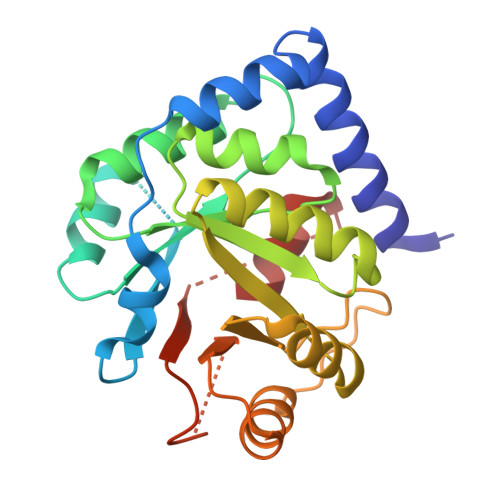Complete computational design of high-efficiency Kemp elimination enzymes.
Listov, D., Vos, E., Hoffka, G., Hoch, S.Y., Berg, A., Hamer-Rogotner, S., Dym, O., Kamerlin, S.C.L., Fleishman, S.J.(2025) Nature 643: 1421-1427
- PubMed: 40533551
- DOI: https://doi.org/10.1038/s41586-025-09136-2
- Primary Citation of Related Structures:
9HVB, 9HVG, 9HVH - PubMed Abstract:
Until now, computationally designed enzymes exhibited low catalytic rates 1-5 and required intensive experimental optimization to reach activity levels observed in comparable natural enzymes 5-9 . These results exposed limitations in design methodology and suggested critical gaps in our understanding of the fundamentals of biocatalysis 10,11 . We present a fully computational workflow for designing efficient enzymes in TIM-barrel folds using backbone fragments from natural proteins and without requiring optimization by mutant-library screening. Three Kemp eliminase designs exhibit efficiencies greater than 2,000 M -1 s -1 . The most efficient shows more than 140 mutations from any natural protein, including a novel active site. It exhibits high stability (greater than 85 °C) and remarkable catalytic efficiency (12,700 M -1 s -1 ) and rate (2.8 s -1 ), surpassing previous computational designs by two orders of magnitude 1-5 . Furthermore, designing a residue considered essential in all previous Kemp eliminase designs increases efficiency to more than 10 5 M -1 s -1 and rate to 30 s -1 , achieving catalytic parameters comparable to natural enzymes and challenging fundamental biocatalytic assumptions. By overcoming limitations in design methodology 11 , our strategy enables programming stable, high-efficiency, new-to-nature enzymes through a minimal experimental effort.
- Department of Biomolecular Sciences, Weizmann Institute of Science, Rehovot, Israel.
Organizational Affiliation:

















